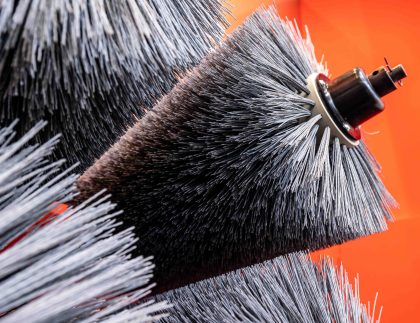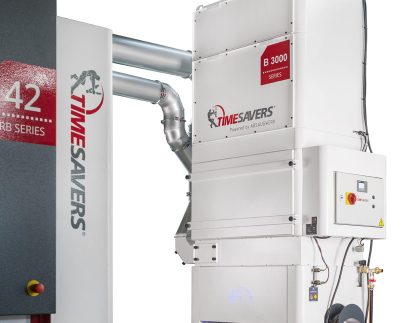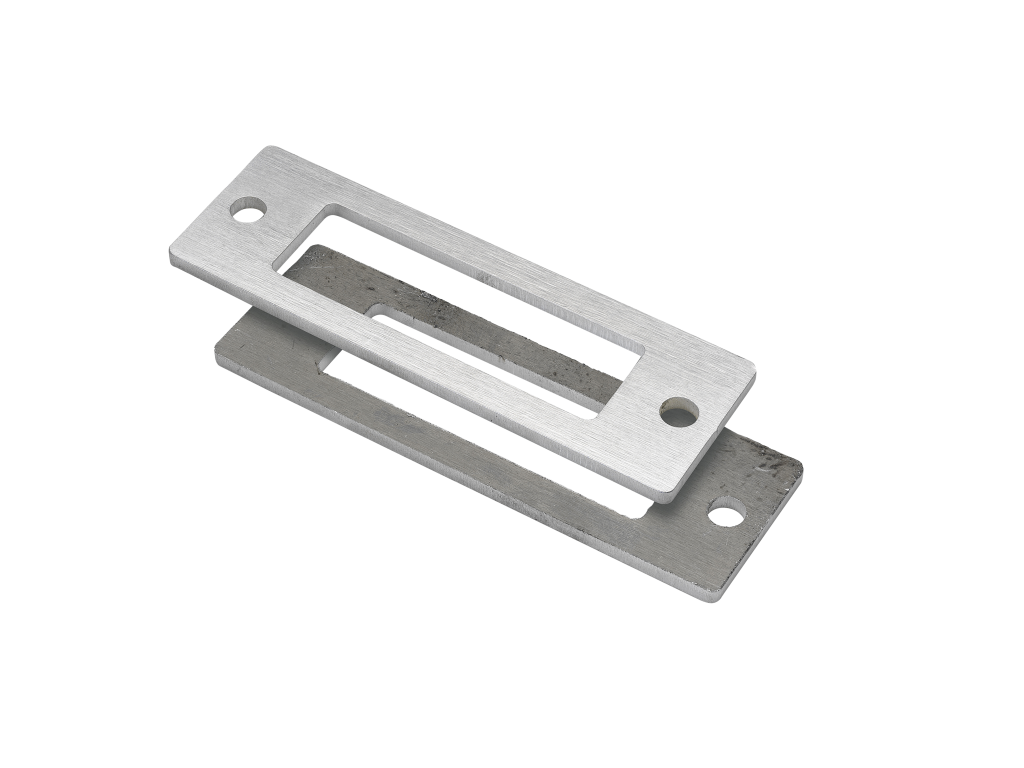It is one thing to know what tools are available to deburr your sheet metal parts. It is another, to know how you can get the desired results, what techniques to use, and who to go to for high quality, yet cost effective machinery. As world-leading specialist in this field for over 80 years, let us explain: What are things you need to consider when grinding aluminium?
Cutting process of aluminium
First a bit of a background story. Aluminium is a soft material and is mostly cut by laser, waterjet or, especially in the aerospace industry, punched or milled to reduce heat generation and corrosion. Just like waterjet cutting is an excellent way to avoid heating of the product. These punched or laser cut parts remain with upstanding and sharp edges and burrs from the cutting tool. This can cause injuries to personnel and make the product look unprofessional. All the more reason to deburr your aluminium parts. There are multiple deburring methods, of which abrasive belt grinding is most popular. Timesavers has over 80 years of knowledge about grinding technology, so contact us if you need help with the application choice.
The right machine tools for processing aluminium
Because aluminium is a very light weighted mineral, it is necessary to choose a machine that can hold the parts in place during the deburring process. Do not underestimate the power of the grinding belts once they grind the thin sheets. The movement of the belt in combination with the grinding dust that gets on the transport belt can really cause the parts to ‘fly’ through the machine. Of course you want to prevent that from happening. Timesavers machine are equipped with a good vacuum table and a sticky transport belt, so small and large pieces can be processed safely.
The rotary brush machines are excellent for processing aluminium for the aerospace industry. This type of aluminium often has cladding alloys that must not be removed by a grinding belt. Rotary brushes only round the edges of punched and milled parts, yet leave the cladding on the surface.
Another choice you will need to make is whether to get a machine that is wet working or dry working. Timesavers offers both. Some have a strong preference for a certain type of deburring machine, since one needs a filter and the other needs a dust extractor. For the differences between wet and dry working machines, please have a look at this page: Wet versus dry machine for deburring or finishing.
Advice: Opt for a good vacuum table or sticky transport belt. At Timesavers, these come in various sizes, so a fitted solution can be offered to any type of company.
Overview of Timesavers machinery
Overview of Timesavers machinery
From entry-level deburring machines to large rotary brush machines for edge rounding. From small finishing machines to coil-to-coil finishing lines. The options are limitless.

Tooling; important for deburring and surface treatments of aluminium
One of the most deciding factors for deburring aluminium is the tooling. Grinding aluminium with abrasive belts causes a lot of dust. For this reason, it is recommended to check the belts for clogging every now and then, to guarantee the deburring quality. To ensure minimal clogging, the Timesavers machines have an automatic cleaning cycle every four hours and can be equipped with the powerful dust extraction from Absaugwerk.
You need a different abrasive belt for every type of material. In case of aluminium, you need a special belt that does not get clogged with grinding dust. This type of belt has the same grit as that of other belts, but there is more space between the grains.
As for brushes, you can deburr aluminium as well as stainless steel with the same set. That will never be the case for the combination of steel and aluminium. Steel and aluminium both need to have their own set of abrasive brushes. Have a look at Timesavers original brush holders to store the multiple sets of brushes.
When aluminium gets anodised to protect the part against corrosion, it is crucial to use the right abrasive mineral. Not every grinding belt is suitable to deburr the aluminium parts in this case. Normally, the silicon carbide belts and brushes are being used for deburring and edge rounding aluminium. In case of anodising, this abrasive could cause ugly spots after the aluminium is treated by this electrochemical treatment.
Advice: Watch out for clogging of the belt by metal dust and please be aware of what abrasive mineral to use when anodising becomes the aluminium surface treatment. Contact us for advice.
For all your questions
For all your questions
Are you curious about the tooling that is available for Timesavers machinery? Or would you like to know what belts or brushes to use for your application?
Ask your questions! Our team will gladly advice you and help you further.

Pressure and speed
Aluminium is a softer metal compared to stainless steel and steel, thus there is no need to apply a lot of pressure when deburring. Too much pressure of the contact roller on the surface, creates unfortunate scratches you definitely want to avoid.
The speed of the abrasive belt also needs to be set correctly. A too slow speed can cause deep scratches, while a high speed generates heat which the aluminium retains. When a part is exposed to such heat for too long, it bends and damages the inside of the machine as well as the product itself. Before you start removing burrs, try the speed and pressure on a test sample. The finished part will show if the settings need to be adjusted or not.
Luckily, you can double the transport speed for aluminium compared to steel and stainless steel, because it is a soft metal. On soft metals you can deburr and round edges easier and faster, while achieving the same results. When you use a higher transport speed it is no problem to also increase the speed of the grinding belt. Before you start removing burrs, try the speed and pressure on a test sample. The finished part will show whether the settings need to be adjusted or not.
Advice: Find the right balance of pressure and speed to avoid scratches, heat absorption and bending of parts. Timesavers helps the machine operators with training, tips and tricks, and is always available for questions regarding the machine settings.
Combustive dust, means thorough cleaning
To ensure a safe working environment it is naturally essential to have an adequate dust extraction for the aluminium dust. This dust is very flammable. Because the dust is not all collected by the extractor, the machine needs a regular cleaning session. Timesavers machines have an automatic cleaning cycle. Every time the machine stops, it cleans itself. When the machine is running 8 hours or even 24/7, it will happen automatically every four hours.
Advice: Make sure to have a good dust extractor and do not forget to clean the machine once in a while. Timesavers values a safe workplace and therefore partnered with Absaugwerk GmbH, a German company specialised in powerful extraction units.
Our partnership with Absaugwerk GmbH
Our partnership with Absaugwerk GmbH
Absaugwerk is supplier for extraction solutions at Timesavers. The B series range consists of high-quality extraction solutions for the protection of people, machines and the environment in the manufacturing industries.

Deburring machine for aluminium
Aluminium deburring machines from Timesavers are designed for ease of use and best results. You can easily adjust the amount of pressure and speed during grinding, to get your desired results. Moreover, the deburring process can be combined with edge rounding and finishing in one pass, resulting in burr free parts with a beautiful surface finish and edge round. For dust extraction, Timesavers has partnered up with Absaugwerk GmbH to accompany each machine series with the right extraction unit.
What is the best way to deburr aluminium in your deburring process? Ask our grinding specialists for custom advice or discover our cutting edge solutions on this machine overview page.
+
Why deburr aluminium?
Aluminium parts that are cut by laser or waterjet have sharp edges and burrs. These can cause injuries to personnel and make the product look unprofessional.
+
What is the right deburring machine for aluminium?
All Timesavers deburring machines are suitable for deburring aluminium. Because there is a variety in sizes, you need to consider the dimensions of your products. That determines the width of the machine. Also, the machine must be able to keep the small and large aluminium parts in place.
+
What tooling can be used for deburring aluminium?
A grinding belt gently removes the burrs from the surface. There is a variety of grinding belts available, but the silicon carbide belt is popular for aluminium that does not get anodised. Abrasive brushes can be the next step to round the edges of parts. Finishing is the final step in the deburring process and can be done with non-woven abrasive belt.
+
How much pressure should I apply when deburring aluminium?
As aluminium is a soft metal, not much pressure is needed. Make sure that the abrasive belt reaches the surface in such a way that it removes the burr but does not leave deep scratches.
+
Why deburr aluminium before anodising?
Burrs and sharp edges can interfere with the anodising process, resulting in an uneven finish. Therefore, the surface of aluminium parts must be smooth and uniform.
+
What happens when deburred aluminium gets anodised?
Anodising deburred aluminium will affect the surface finish. The roughness will slightly increase. To avoid stains on the anodised aluminium, it is important to use the right abrasive for deburring.
+
What is the right deburring machine for aluminium?
All Timesavers deburring machines are suitable for deburring aluminium. Because there is a variety in sizes, you need to consider the dimensions of your products. That determines the width of the machine. Also, the machine must be able to keep the small and large aluminium parts in place.
+
What to do with aluminium grinding dust?
Avoid the risk of sparks or fire and equip your deburring machine with a wet dust extractor. The air gets filtered and can be led back inside the hall or outside. Moreover, it is important to clean your machine regularly to avoid clogging of belts or the vacuum table.
